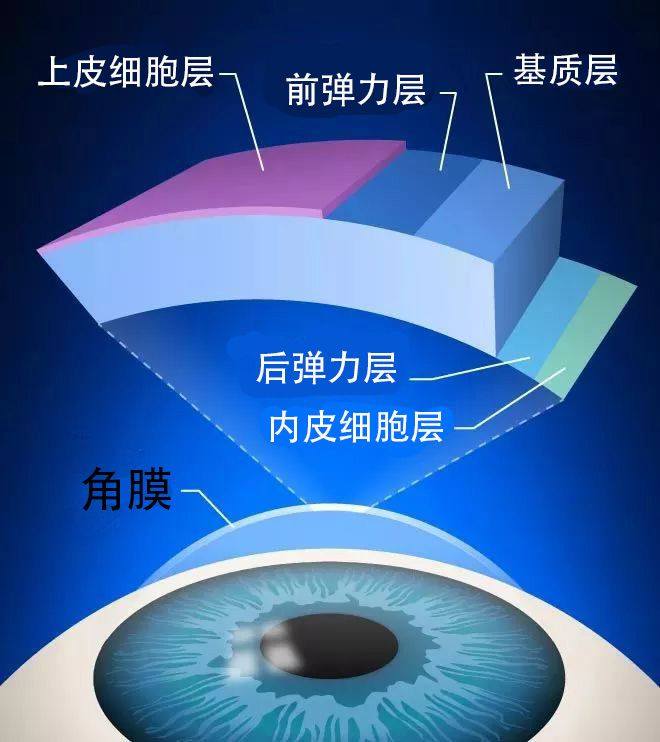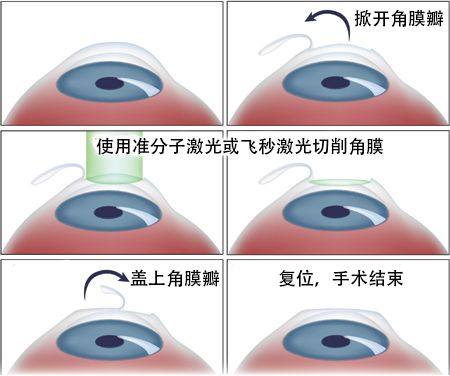
My major is optometry, so most of the patients I come into contact with in the clinic are patients with vision problems. It is part of my daily work to help them choose the most suitable correction method.
Today we will talk about laser surgery to correct vision.
At present, there are three main methods to correct vision: frame glasses, contact lenses and lens removal surgery.
The most familiar lens removal operation is laser surgery. The technology is quite mature and can help people get rid of the trouble of glasses. It has become the choice of more and more people.
Laser surgery, in short, is to use laser to cut the cornea.
The cornea is equivalent to the lens of our eyes. By polishing this lens to make it more suitable for our eyes, we can see clearly.
There are many ways of laser surgery now, but no matter which one, it is to cut the cornea.
Corneal structure
Cornea, according to anatomical structure, can be divided into 5 layers from front to back:
Epithelial cell layer, anterior elastic layer, matrix layer, posterior elastic layer and endothelial cell layer.
Schematic diagram of corneal structure:

The most superficial layer is the epithelial cell layer, which is tightly connected and forms the corneal barrier.
Epithelial cells have the ability to regenerate and can generally recover quickly without leaving traces after injury. The stroma layer is located in the middle of the cornea, accounting for 90% of the corneal thickness, and is composed of collagen fibers. It cannot regenerate and will leave scars after injury healing.
According to the different levels of corneal ablation, laser surgery can be divided into two types: corneal surface surgery and corneal stroma surgery.
Surface corneal surgery
Corneal surface surgery is to cut the corneal epithelium or subepithelium.
Taking PRK (Simple Surface Excimer Laser Keratectomy) as an example, I will give you a brief introduction to how the lower surface surgery is done.
Operation procedure:
1. Point anesthetic on the surface and soften cornea with alcohol;
2. Scrape off corneal epithelial tissue;
3. Corneal ablation with excimer laser;
4. Wear a bandage lens (a soft contact lens for treatment) to protect the cornea and wait for epithelial regeneration.
Schematic diagram of PRK operation:


Main advantages: corneal structure is still tight and stable after operation; The aberration after operation is smaller. There are few dry eyes after operation. In short, the cornea will be stronger after surgery.
Main Disadvantages: Postoperative Pain; Subepithelial haze (HAZE) may occur, requiring longer use of hormone eye drops, which may cause elevated intraocular pressure.
Corneal stroma surgery
Corneal stroma surgery is to cut the corneal stroma and is currently the most common laser surgery method.
The surgical methods include LASIK (excimer laser in situ keratomileusis), half femtosecond and full femtosecond.
Let’s take a look at how to do it separately.
1. LASIK/half femtosecond
LASIK is the same as half femtosecond surgery, except for the laser used.
Operation procedure:
1. Make a corneal flap;
2. Open the corneal flap;
3. Cut that matrix layer with excimer lase or femtosecond laser;
4. Cover the corneal flap back.
LASIK/Half Femtosecond Surgery Schematic Diagram:


2. Full Femtosecond
All femtosecond and half femtosecond are the same, using femtosecond laser, the difference is that corneal flap is no longer made.
Operation procedure:
1. Scanning the matrix layer with femtosecond laser to make a lens;
2. Make a small incision around the cornea;
3. Take out the lens from the small incision.
Schematic Diagram of Full Femtosecond Surgery:


Main advantages: Protect corneal epithelium without too much pain; It can improve the opacity of corneal epithelium.
Main Disadvantages: There will be gaps between the stroma layers, and the stability of the cornea will be affected. Simply put, it is not as strong as before operation. If the corneal flap is made, there will be risks such as corneal flap displacement.
Which operation is better?
At present, in clinical practice, stroma surgery is generally recommended, and postoperative vision recovery is faster. For most people whose cornea is not too thin, LASIK or half femtosecond can be selected. The two surgical methods are basically the same, but femtosecond laser has better accuracy, less tissue trauma, and more controllable postoperative results. It is recommended to give priority.
For patients with myopia within 1000 degrees, corneal thickness is sufficient, and they can accept relatively high cost, full femtosecond surgery is a good choice.
All femtosecond surgery does not need to make corneal flap, which can avoid a series of related surgical complications. However, if myopia regression occurs after surgery, in-situ reinforcement cannot be performed, so it is not suitable for patients with young age and unstable degree.
For patients with low diopter, thin cornea or high-risk occupations such as athletes, surface corneal ablation is the first choice.
In general, whether or not to perform laser surgery and which is more suitable for oneself should be decided by detailed preoperative examination and detailed communication with doctors according to the results and personal needs.
